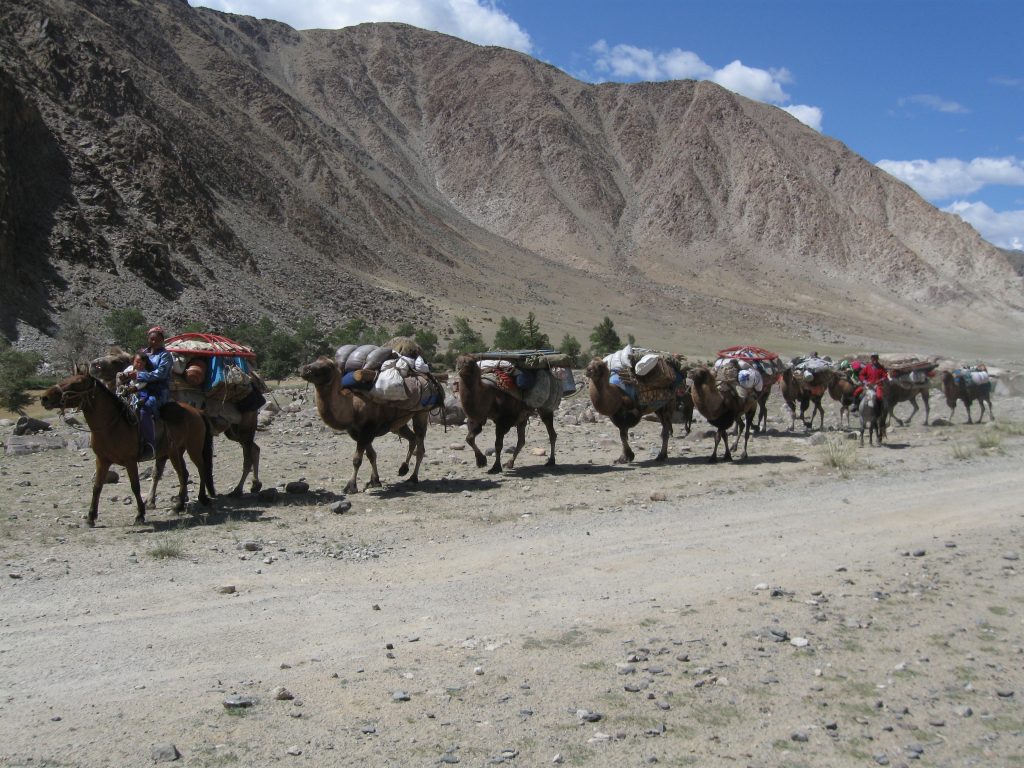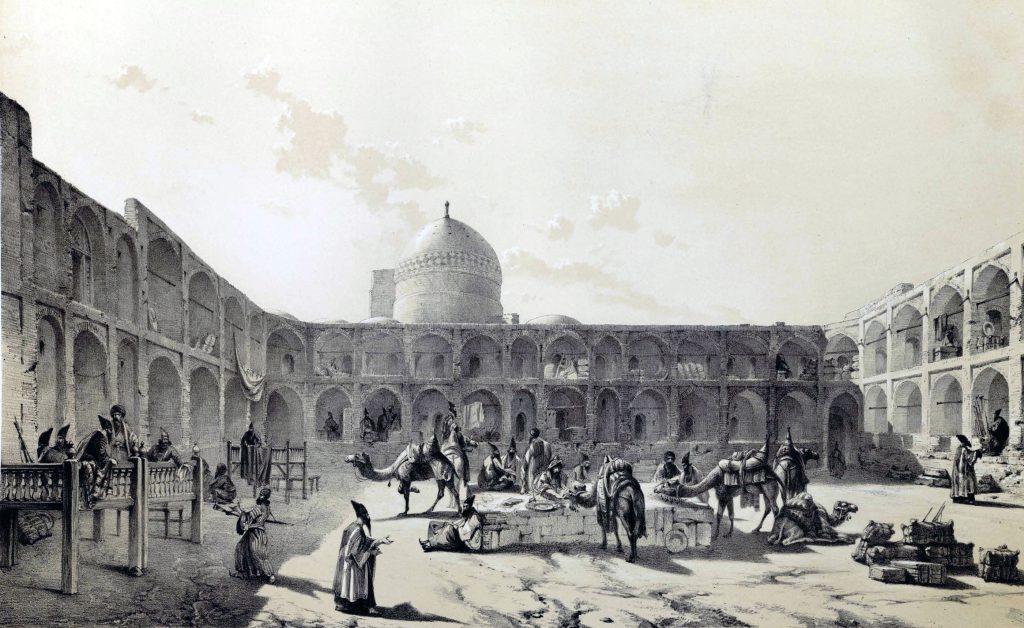The Silk Ribbon of Highways
A thousand years ago, the Silk Road was in its heyday. Caravans hauling tons of commodities and luxury goods crisscrossed Asia and the Middle East from Xi’an, China, in the east to Constantinople (now Istanbul), Turkey, in the west. Major trading centers along the way included Baghdad in Iraq, Samarkand in what is now Uzbekistan, and Turfan in western China.
First called the Silk Road (Seidenstraße) in 1877 by German adventurer Baron Ferdinand von Richtofen, this name highlights trade in a single luxury product that was shipped west from China to the Roman Empire beginning at about the time of Christ. Von Richtofen’s shorthand oversimplifies a wonderfully complex economic, social, and cultural phenomenon.
In actuality, there was no single Silk Road. Rather, there was a complex network of roads and trails crisscrossing Central Asia. Von Richtofen could just as easily have called this trade route the Glass Road in recognition of the vast quantities of Roman glass shipped to China in exchange for silk. He could have called it the Bubonic Plague Road for the horrible epidemic that spread west through the network in the 1300s before decimating Europe. Or he could have called it the Buddhism Road, since Buddhism spread from India to China along portions of the Silk Road roughly 2,000 years ago. Monikers aside, the Silk Road is one of the true wonders of the ancient world; portions of it were recently designated a UNESCO World Heritage Site.
To me, the two most striking aspects of the Silk Road would have been the rest stops, called caravanserais, and the Bactrian camels that schlepped most of the cargo. (Although wheeled carts were commonly used in many parts of the world during the trade network’s heyday, the rough, mountainous terrain made wheeled transport impractical.)
Caravanserais were oasis-like way stations located roughly a day’s journey apart along the vast expanse of the Silk Road. At these roadside oases, travelers could rest themselves and their animals, replenish supplies, chat with fellow travelers, and generally gain respite from their arduous tasks. We know a lot about caravanserais because they are described in historical documents and are well-preserved in archaeological sites. We know there would have been lots of different people concentrated in a centrally located space, enjoying exotic sights, sounds, smells, and tastes that they might never encounter again.
As sensational as the caravanserais likely were, they, and indeed the entire Silk Road, would not have existed if it weren’t for the double-humped Bactrian camel—decidedly not to be confused with its single-humped brethren, the dromedary, or Arabian camel.
The Bactrian camel is a remarkable creature. Well-adapted to the harsh conditions of Central Asia, it can easily withstand temperatures ranging from minus 40 degrees Fahrenheit in winter to over 100 degrees Fahrenheit in summer. It can eat a wide variety of plant matter, including species that most other animals—especially humans—won’t touch. It doesn’t sweat until its body temperature reaches 106 degrees. It can go long periods without water, and then it can drink up to 30 gallons in 15 minutes when presented with an opportunity. (Its humps don’t store water, they store fat for energy.) It has flat, roughly circular foot pads that are superb for walking on a wide range of surfaces. It has two rows of eyelashes and its nostrils can close tight—ideal adaptations for protection during sand storms. Better still, it can walk up to 30 miles per day while carrying up to 500 pounds.
Bactrian camels were in my head as I recently drove a long, 32-hour round-trip from Denver to Chicago (yes, I drove my family there to cheer on the Cubs during the World Series). I got to thinking: Might the modern U.S. interstate highway system be a reasonable analog for the ancient Silk Road? Certainly, commodities and luxury goods, not to mention people and ideas, travel the nation’s highways; that’s why they were built. (They were also designed to allow for quick evacuation of cities in the event of a nuclear attack. Ah, good old Cold War logic.)
And if the highway system is today’s Silk Road, does the Bactrian camel have a modern analog? The semitractor-trailer is a logical candidate. In some ways, these trucks are as tough as Bactrian camels, with engines designed to last 800,000 miles or more. In others, they offer no comparison—they are good only on paved roads and typically run on just one type of fuel.
What about the trailers? Have you noticed that a lot of truck trailers have “53’ ” written on the back? That number refers to the fact that the container, which may or may not be permanently attached to the trailer, is 53 feet long. Why 53 feet? Because the U.S. Surface Transportation Assistance Act of 1982 legislated that length as the U.S. Department of Transportation’s agreed-upon standard for most trucks. That length allows each container to hold 13 rows of standard 40-by-48-inch shipping pallets plus an extra foot that allows the doors to be closed safely and efficiently. Given that the previous standard length was 40 feet, the new 53-foot standard allows each truck to carry a lot more cargo, thus putting more money directly into the shipper’s pocket. In contrast, the average Bactrian camel is about 10 feet long and cannot be modified.
In our globalized world, efficiency’s gain is diversity’s loss. To me, Flying J truck stops, Super 8 motels, and McDonald’s restaurants are not nearly as interesting as the bustling, ancient caravanserais. And the standardized aspects of modern, global transportation technology don’t hold a candle to the toughness and talents—not to mention personality—of a healthy Bactrian camel. Sure, travel along the Silk Road would’ve been much, much slower and more dangerous than that on a modern ribbon of highway. Still, as I cruised along at 75 mph and the kids watched videos, I couldn’t shake the feeling that we’re missing something sensational, in all meanings of that word, in our present-day quest for speed.
Maybe we should take more time to stop and smell the roses—and the frankincense and myrrh.



































